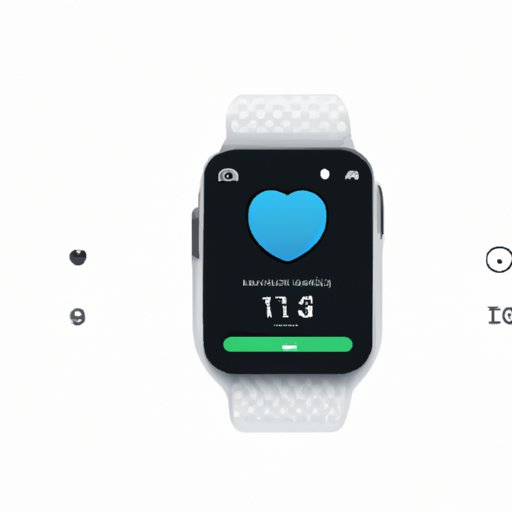Introduction
The Apple Watch is one of the most popular smartwatches on the market, and it has become increasingly popular for tracking fitness activities. But just how does the Apple Watch measure exercise? In this article, we will explore the sensors and technology behind the Apple Watch’s exercise-tracking capabilities, an overview of how it measures your workouts, a comprehensive guide to its features, and how does it track your exercise. We will also compare the Apple Watch to other wearables for exercise tracking so that you can make an informed decision about which device is right for you.
Exploring the Sensors and Technology Behind Apple Watch’s Exercise-Tracking Capabilities
The Apple Watch uses a variety of sensors to accurately track your physical activity. The watch contains a built-in accelerometer, which measures acceleration as you move. It also has a gyroscope, which measures orientation and motion. Both of these sensors allow the watch to detect when you are running, walking, or otherwise moving. Additionally, the watch contains a heart rate monitor, which tracks your heart rate throughout the day, as well as during workouts.
Using this data, the Apple Watch can accurately track your physical activity and provide real-time feedback about your progress. For example, the watch can tell you how many steps you’ve taken, how many calories you’ve burned, and even your average heart rate during a workout.

An Overview of How the Apple Watch Measures Your Workouts
The Apple Watch can track a variety of different types of workouts, including running, walking, cycling, swimming, and more. It also tracks your daily activity levels, such as the number of steps taken, the amount of time spent standing, and the number of calories burned. Additionally, the watch can measure your heart rate during workouts, as well as track your sleep patterns.
The Apple Watch also provides detailed metrics for each type of workout. For example, if you are running, the watch will measure your speed, distance, and elevation gain. It will also track your heart rate and give you an estimated calorie burn. For swimming, the watch will track the number of laps, strokes, and distance.
A Comprehensive Guide to Apple Watch’s Exercise Tracking Features
The Apple Watch offers several features to help you track your workouts. The Activity app gives you an overview of your daily activity, including your step count, calories burned, and other metrics. The Watch also has a heart rate monitor, which allows you to track your heart rate during workouts. Additionally, the watch can set goals for you to reach and alert you when you are close to achieving them.
The watch also has several other features specifically designed for tracking exercise. You can use the Workout app to track specific types of workouts, such as running, cycling, or swimming. You can also use the watch to track your progress over time, as well as sync your data with other fitness apps. Finally, the watch can remind you to keep up with your workouts and reward you for meeting your goals.
How Does the Apple Watch Track Your Exercise?
The Apple Watch uses two main sensors to track your exercise: an accelerometer and a GPS tracker. The accelerometer measures your movement and allows the watch to detect when you are running, walking, or otherwise engaging in physical activity. The GPS tracker then records your location, allowing the watch to track the distance and speed of your workouts.
In addition to the sensors, the watch also uses algorithms to calculate the intensity of your workouts. This allows the watch to accurately track the number of calories burned, as well as other metrics such as steps taken, average heart rate, and more.
The Benefits of Using the Apple Watch for Measuring Exercise
The Apple Watch offers several benefits for tracking your exercise. Firstly, it is highly accurate in tracking your workout data. It is also able to track a variety of different types of workouts, from running to swimming, and provide detailed metrics for each. Furthermore, the watch allows you to set goals and track your progress over time, making it easier to stay motivated and achieve your fitness goals.

Comparing the Apple Watch to Other Wearables for Exercise Tracking
When it comes to choosing the right wearable for exercise tracking, there are a few things to consider. Firstly, battery life is an important factor, as you don’t want your device dying in the middle of a workout. The Apple Watch has an impressive battery life of up to 18 hours, depending on usage. Additionally, the watch is water-resistant up to 50 meters, meaning you can take it swimming without worrying about damage.
The accuracy of the tracking is also important, and the Apple Watch is one of the most accurate devices on the market. Finally, price is an important factor, and the Apple Watch has a wide range of prices depending on the model. The entry-level model starts at $199, while the top-of-the-line model can cost up to $799.
Conclusion
In conclusion, the Apple Watch is an excellent choice for tracking your exercise. It uses a variety of sensors and algorithms to accurately track your physical activity, as well as provide detailed metrics for each type of workout. Additionally, the watch has several features designed to help you stay motivated and achieve your fitness goals. Finally, the watch has an impressive battery life, water resistance, and a wide range of prices, making it a great option for those looking to track their exercise.
(Note: Is this article not meeting your expectations? Do you have knowledge or insights to share? Unlock new opportunities and expand your reach by joining our authors team. Click Registration to join us and share your expertise with our readers.)
